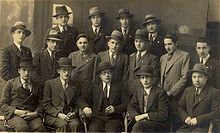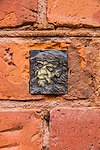Telz Yeshiva
It is a Haredi (ultra-orthodox) institution of Torah study, with additional branches in Chicago and in New York. It is the successor of the New Haven Yeshiva of Cleveland.
History

In 1875 it was founded in the town of Telshi (Lithuanian: Telšiai, Russian: Тельши, Yiddish: טעלז, romanized: Telz) in Kovno Governorate of the Russian Empire. By 1900 it was "one of the three largest yeshivot in Imperial Russia."
The yeshiva was established by three Orthodox rabbis and Talmudists:
- Meir Atlas, later the rabbi of Shavli) and the father-in-law of Elchonon Wasserman and Chaim Ozer Grodzensky;
- Zvi Yaakov Oppenheim, who later became the rabbi of Kelm; and
- Shlomo Zalman Abel, the brother-in-law of Shimon Shkop.
Rabbi Eliezer Gordon

In 1883, Eliezer Gordon was appointed as the chief rabbi of the town of Telz and in 1884, rosh yeshiva (dean) of the yeshiva. A student of Yisrael Salanter, he had been a maggid shiur (lecturer) in Salanter's yeshiva, and a rabbi in Kelm, with a short stint in Slabodka (a suburb of Kaunas/Kovno). The yeshiva eventually became one of the largest in Imperial Russia. Gordon added his son-in-law, Yosef Leib Bloch, to the faculty, and in 1885, he hired Shimon Shkop.
In 1894, the yeshiva moved from its Telz community-provided building into a new facility. That year, it added a new subject of study, mussar (Jewish ethics). Ben Zion Kranitz was hired for a new faculty position: mussar mashgiach (teacher of ethics). In 1897 Gordon hired Leib Chasman, who instituted a very strict mussar regime in the yeshiva which many students opposed.
In 1902, Shkop left to become the rabbi of Breinsk, Lithuania. In 1905 Chaim Rabinowitz joined the yeshiva.
In 1910, while fundraising for the yeshiva in London, Gordon died of a heart attack.
Rabbi Yosef Leib Bloch
Gordon's son-in-law Yosef Leib Bloch became the community's rabbi and the rosh yeshiva. In 1920, he established primary schools in Telz for boys and girls, and also added a mechina ("preparatory school") to the yeshiva.
Parallel to an easier version of the yeshiva curriculum, the mechina also featured secular studies, another innovation at the time. In 1924 the Lithuanian government announced its decision to accredit only those rabbinical colleges that possessed a secular studies department. The Rabbinical College of Telshe was the only such institute, although secular studies were only in its mechina.
A kollel (postgraduate institute) opened in 1922, to train graduates for the rabbinate. Bloch's son-in-law Chaim Mordechai Katz was dean (rosh hakollel).
Yavneh School
In 1918, a teachers training institute was opened in Kovno but did not achieve much success. In 1925 The Yavneh School for the Training of Teachers reopened in Telz under the auspices of The Rabbinical College of Telshe. This served as a postgraduate institute, with the charter of producing teachers for Jewish schools. The curriculum at the teacher's institute included educational skills, Hebrew Bible, Talmud, the Hebrew language and literature and mathematics.

For many years the Jewish community in Lithuania had lacked a structured educational system for teenage girls. In 1927 a high school department for girls was established in Telshe.
In 1930, a sister institute to The Yavneh Teacher's Training Institute was opened by Joseph Leib Bloch of Telz. The school offered a two-year course to young women.
These various schools were all incorporated as a part of The Rabbinical College of Telshe.
In October 1930 Yosef Leib Bloch died and his second oldest son, Avraham Yitzchak Bloch succeeded him as both community rabbi and rosh yeshiva.
Rabbi Avraham Yitzchak Bloch

In the 1930s older students in the yeshiva were selected to teach for periods of time at new schools in small towns where there had previously been little or no structured schooling, and then return to continue their studies at the yeshiva.
Rabinowitz died in the year 1931 which was the year Yosef Leib Bloch and his son Azriel Rabinowitz, was appointed as a rosh yeshiva.
In 1933, the yeshiva built a new building to house the mechina ("preparatory school").
The Holocaust
In the fall of 1939, the Russians were allowed to bring troops into Lithuania on the pretext of defending the country. In June 1940, the Russians seized control of the country and quickly transformed it into a "soviet socialist republic." As part of this transformation, private Jewish organizations and schools were disbanded and the yeshiva was closed. Most of the students dispersed, with only about a hundred students remaining in Telshe. The learning was done in groups of 20-25 students, studying in various batai medrashim ("small synagogues") led by the rosh yeshivas.
During the early years of World War II, Elya Meir Bloch and Chaim Mordechai Katz were in the United States on a fund-raising mission. As the war broke out, their only option to ensure the continuity of the Yeshiva was to rebuild Yeshiva on American soil. This Yeshiva was thus rebuilt in Cleveland Ohio.
In October 1940, a group of students led by Chaim Stein escaped via Russia. This group found its way to the United States in early 1941 and joined the Yeshiva in Cleveland.
Telshe in the United States
The yeshiva was opened in Cleveland in the house of Yitzchak & Sarah Feigenbaum on November 10, 1941. As of 1954, it became officially titled the Rabbinical College of Telshe. They relocated to the present Wickliffe location in 1957.
Telshe consists of a high school, college and post-graduate school. The yeshiva is a non-profit and is accredited through the Association of Advanced Rabbinical and Talmudic Schools. The yeshiva has a department of secular studies that grants a high school diploma.
In the United States the original faculty included Elya Meir Bloch, Chaim Mordechai Katz, Boruch Sorotzkin, Mordechai Gifter, and Chaim Stein.
The 2013 student count of 130 included 80 in grades 9-12; the highest student count, in 1966, was about 425.
Notable alumni
Among the well-known alumni of the yeshiva are:
- Chaim Yitzchak Hacohen Bloch, Chief rabbi of Bausk and Plunge
- Noson Ordman, Rosh Yeshiva Etz Chaim Yeshiva (London)
- Naftoli Carlebach, Orthodox Jewish rabbi and accountant
- Nachum Zev Dessler, Cleveland, Ohio
- Azriel Goldfein, founding Rosh Yeshiva of Yeshivah Gedolah of Johannesburg
- Chaim Gutnick, Melbourne Australia
- Chaim Dov Keller, Chicago, Illinois. Rosh Yeshiva of Telshe Chicago
- Zev Leff, Moshav Mattityahu, Israel
- Moshe Leib Rabinovich
- Avraham Tanzer, Rosh Yeshiva at Yeshiva College of South Africa
Branches
- Telshe Chicago. In 1960, the yeshiva opened a branch in Chicago, Illinois. Within 10 years the branch in Chicago became independent of the yeshiva in Cleveland and no longer has an official formal connection to the yeshiva in Cleveland, although informal ties remain close.
- Kiryat Ye'arim (Telz-Stone), Israel. In 1977, Mordechai Gifter brought a group of 20 students from Cleveland to open a branch of the yeshiva in Kiryat Ye'arim (Telz-Stone), Israel. Classes took place in several apartments. In 1979, when Baruch Sorotzkin died, Gifter was asked to return to Cleveland and the Israeli branch closed.
- Yeshiva of Telshe Alumni. In the early 1980s, Avraham Ausband, a grandson of the Telzer Rov Avraham Yitzchak Bloch, was sent to open up the Yeshiva of Telshe Alumni in Riverdale, New York by his Rebbe, Mordechai Gifter.
- Birchas Chaim. In 2001 Chaim Stein's son, Shmuel Zalman Stein, opened Yeshivah Birchas Chaim in Lakewood, New Jersey.
Gallery
-
Telšiai Yeshiva art
-
Telšiai Yeshiva building
See also
References
- ^ "about 130" (2013). Ed Wittenberg (August 23, 2013). "Telshe Yeshiva hidden gem in Lake County". Cleveland Jewish News.
- ^ Grades 9-12 had 57 in Fall, 2009. "Total Headcount Enrollment at Private Ohio Institutions, Fall 2000 to Fall 2009" (PDF). Ohio Department of Higher Education. Retrieved March 4, 2018.
- ^ Shaul Stampfer. "Telz, Yeshiva of". YIVOencyclopedia.org.
- ^ YIVO says "around 1870" but 1875 is when it became more than a minor local institution. "Telshe". JewishGen.org.
- ^ "Telshe Yeshiva". February 5, 2019. Retrieved December 10, 2019.
- ^ Lusch, L., ed., The late Rabbi Leib Chasman, People and Personalities, in The Shtutshin Community [1]
- ^ "Dr. Yitzhak Etzion, Pioneer Educator, Dies at 96". JTA.org. October 28, 1981.
- ^ "(Reb Chaim Telzer, 1856-1931). Autograph Postcard Signed, written in Hebrew to Libor Hirschowitz of Hebron, Eretz Israel".
- ^ 1941: Marcy Oster (June 30, 2011). "Rabbi Chaim Stein of Cleveland's Telshe Yeshiva dies". JTA (Jewish Telegraphic Agency.
- ^ Keller, Chaim Dov. "Rabbi Eliahu Meir Bloch: He Brought Telshe to Cleveland". Archived from the original on June 5, 2011. Retrieved February 7, 2011.
- ^ "Marking 70 Years Since the Rebirth of Telshe in America". COMMUNITY Magazine. Archived from the original on July 27, 2011. Retrieved February 7, 2011.
- ^ "Rabbi Chaim Katz, President of Famed Telshe Yeshiva, Dead; Was 70". JTA.org. November 19, 1964.
- ^ Rose, Binyamin. "The Prince of America's Torah Renaissance: An appreciation of Rav Mordechai Gifter, ztz"l, on his tenth yahrtzeit". Mishpacha, 29 December 2010, pp. 33–34.
External links
- Telshe Yeshiva (Official website)
- An explanation and synopsis of the Telzer Derech
- Catalog of historic items from Telshe Yeshiva in Ohio
- "An Analysis of Darchei HaLimud (Methodologies of Talmud Study) Centering on a Cup of Tea"
- History of the town of Telsiai (shtetlinks)
- The Ohel Tomb of Reb Eliezer Gordon in Edmonton Beis Olam London with photos of the Matzeivo

